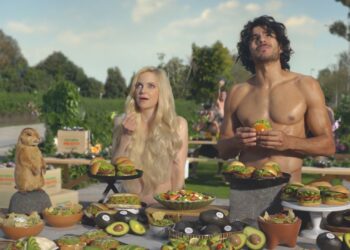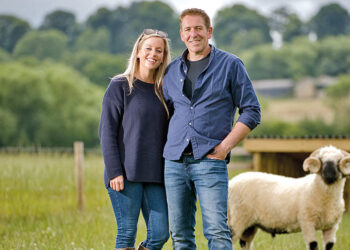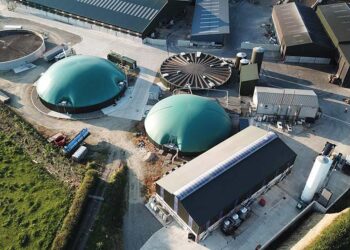This excerpt has been edited for length. Transfarmation: The Movement to Free Us From Factory Farming, is available for purchase now.
In the spring of 2014, I found myself sitting across from a man who was by every definition my enemy. His name was Craig Watts and he was a chicken factory farmer, raising chickens for slaughter. My career is devoted to protecting farmed animals and ending factory farming. Until that point, I’d spent my whole life working against everything Craig Watts stood for. Now I was sitting in his living room.
As I sat there, a thousand questions were swirling in my mind. I’d been trying for years to get footage from inside a chicken factory farm at a time in our country when seeing inside a chicken farm was—and still is—nearly impossible. I’d failed every previous attempt.
That day, I’d driven from my home in Atlanta to Craig’s home in rural North Carolina. Before I left, I gave my husband the address and told him, “If I don’t come back, look for me rotting away in the chicken litter.” I was convinced I was heading into an ambush, not knowing my life would soon be changed forever.
Prior to our meeting, Craig Watts had been raising chickens for twenty-two years in factory farms for Perdue, the fourth-largest chicken company in the United States. When Craig was a young adult, he had searched for a way to stay on the land that had been passed down in his family for five generations, in one of the poorest counties in North Carolina. There were very few jobs in the area, so when Perdue came to town and offered him a contract to raise chickens, it sounded like a dream come true. He took out a $200,000 loan from the bank to build the chicken houses while Perdue agreed to pay him for each flock he raised. With that money, he planned to pay off the loan, as you would a mortgage.
But soon the chickens started to get sick—it was a factory farm, after all. Twenty-five thousand chickens were stuffed wall-to-wall in darkened warehouses, living on their own feces, breathing air thick with toxic ammonia. Many of the sick chickens died, and you don’t get paid for dead chickens. Craig started to struggle to pay off his loan. His paychecks got smaller, but the bills kept coming. Soon he wanted out, but he’d been trapped. Now he was all but an indentured servant, and if he stopped, he’d risk losing everything.
By the time he and I met, Craig had reached a breaking point. His payments seemed never-ending, and so did the illness, death, and despair of the chickens. He was ready for a change. Through late afternoon conversations, and much soul-searching, I realized that I had overlooked an ally. I learned that chicken factory farmers wanted to see factory farming change about as much as animal rights activists did. We had been over-looking each other all these years.
Throughout the summer of 2014, I came back many times with my filmmaker partner Raegan Hodge to learn from Craig. I walked those warehouses as Craig explained the problems, as he picked up the chickens who had died or had to be killed because they had messed-up legs, trouble breathing, difficulty walking. All of these horrors, all of our conversations, were captured on film.
In the winter of 2014, after months of filming and learning to trust each other, Craig and I did something neither of us expected to do. We decided to release the footage together. This was a huge risk. He feared losing his income, his land, and having his neighbors hate him. But he did it anyway. The New York Times broke the story. Within twenty-four hours, a million people had seen our video about the horrors of chicken factory farming. Our story went viral. Suddenly, we had a megaphone. Our unlikely alliance put the truth about factory farming on a global platform.
Too often we become so entrenched in our values, in our fight, that we don’t stop to consider what we might have in common with the so-called opposition. We jump straight to the differences. And it is often the tyranny of small differences that holds progress hostage. Craig was the very first chicken factory farmer I ever connected with, but there would be many more.
Watts and Garcés hold mushrooms grown in a former chicken barn. (Photography by Transfarmation / Mercy for Animals)
In the United States, we still hold close an image of a quaint, independent family farm. But what actually exists is industrial animal agriculture, a system that does more harm than good. If you cross the country, no matter what state you are in, you’ll find a similar story. There is a person in a poor rural county who is searching for a way to stay on the land that had been passed down in their family for generations, searching for a way to make their living off the land and live out their version of the American dream, one in tune with nature and set to the soundtrack of crickets, cicadas, warblers, and chickadees. With few jobs around, the chicken industry’s offer sounds like a dream come true. This farmer often ends up just like Craig.
Meeting Craig would change my trajectory as an activist. We’d become close friends, collaborators, and conspirators in the decade that followed, working to dismantle factory farming piece by piece. We’d see that we’d been fooled. As Craig said: “We were red ants and black ants trapped in a jar. And then someone would shake the jar and we’d start fighting each other. But we’d never stop to question—who’s shaking the jar?” And I’d ask, “Why are we trapped in this jar?” The years ahead, we’d look to smash the jar and remove the shaker’s power. We’d look to reform our food system away from industrial animal agriculture and remove the power of Big Animal Agriculture—the great monopolies with strongholds over our political and economic systems.
read more
They Once Worked in Factory Farming. Not Anymore
When it comes to the meat, dairy, and eggs we eat, the price at the grocery store or restaurant is never a fair reflection of the true cost. In factory farming, risks and liability are mostly externalized by the industry, and most often to the most vulnerable among us. This damage, this harm, is borne by many—from the workers to the animals to the farmers. The industry makes extraordinary profits off this harm by externalizing risk and liability. Externalities are the root of the business model, and they’ve driven the spectacular success, power, and wealth of this industry. But because these costs are hidden from those who purchase the products, consumers don’t affirmatively consent to the harm caused by eating animals and their products.
The workforce in slaughterhouses, the communities living around factory farming, and, in recent years, refugee communities who’ve been brought in as the next generation of farming communities are some of the most affected. These vulnerable communities lack political and social capital, and they have few choices and little ability to fight against the harm that factory farming imposes upon them.
In slaughterhouses, some immigrant workers have documentation and some don’t, but regardless of their situation, if they complain they take risks. When people die on the job, the federal agencies don’t respond 85 percent of the time, according to Civil Eats. Agricultural work is some of the most dangerous work in the country, ranking third among all occupations in fatal injuries together with forestry, fishing, and hunting. According to Civil Eats, animal confinement workers are subject to long-term lung and acute respiratory injuries from their work environments and are exposed to asphyxiating gases from manure.
Black communities in the South, many of whom are descendants of enslaved people, are also disproportionately affected by factory farms. Maps of North Carolina clearly show higher clusters of factory farms surrounding historically Black and low-income rural communities. Studies indicate that in some communities in North Carolina, for example, there are ten times more concentrated animal feeding operations (CAFOs) in low-income and Black and Brown neighborhoods than in higher-income, whiter areas. This is a clear example of environmental racism, a form of institutional racism where environmental hazards and harms are disproportionately distributed in and around communities of color. Where once these communities enjoyed the land that meant so much to their families’ freedom and history, that enjoyment is now ruined. Now they are surrounded by hog and chicken farms, unable to even leave their homes without suffering the smells, flies, and even spray from the farm’s waste.
As the pool of people willing to take on the perils of working in factory farms and slaughterhouses diminishes, the industry has begun to recruit a new, unsuspecting crop of factory farmers: refugees fleeing persecution in war-torn countries. From Burma to Cambodia to Laos, families looking for opportunity and escape come to the US and take on factory farming, only to find themselves trapped and unexpectedly in danger again.
Though farmers, workers, and animals have been suffering for decades, the system responsible for their collective oppression was thrust into the public eye during the pandemic. The attention it received was unprecedented, as was the desire for change.
Transfarmation
During this time of great loss and uncertainty, the people closest to factory farming—farmers, slaughterhouse workers, and communities living next to factory farms—who had already begun to build a new way, accelerated their efforts. They were tired of feeling vulnerable to the fragility and oppression of factory farming.
In late 2019, Mercy For Animals, the organization I lead, launched a new project. We called it the “Transfarmation Project,” and it aimed to be a platform where we could support farmers wanting to make the transition from animal agriculture to plants. It built on the work Craig and I started all those years earlier. But it ended up being so much more. In the years that followed, I would continue my curious journey through rural America, meeting farmers and together rolling up our sleeves to set out a road map for a new rural economy—everything from hemp to mushrooms to lettuce and whatever other innovations we could dream up.
Read more
Q&A with author Leah Garcés
This book is about more than individual farmers going through a career transition. It is about how we transition away entirely from factory farming. Many times, when people are tackling systemic challenges, they write about either the problem or the solution. But a gulf is left in the middle—the complexity of how. This book peers deeply into that gulf, at the transitional moment, and shows how it might be done, through the experience of those who are already doing it. It is told in three parts from the perspective of those closest to factory farming: farmers, the animals, and vulnerable communities working in or near factory farms or slaughterhouses.
This book is about smashing the jar and changing the common narrative that this food and farming system is serving us well. It is about rebuilding our food systems so that we are not trapped in a container, controlled by a monopoly causing us harm. Instead, we are in a collaborative, community-built network that honors all animals and nature, unlocks our highest potential, and empowers everyone to thrive.
The post Transfarmation: The Movement to Free Us From Factory Farming appeared first on Modern Farmer.













